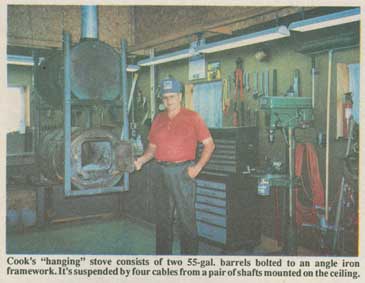
When Lorin Cook designed a heating system for his new shop, he decided to save floor space by building a "hanging" wood-burning stove attached to an electric hoist that raises it up over the work area even when it's being used.
The stove consists of two 55-gal. barrels bolted to an angle iron framework. The framework is suspended by four 1/8-in. dia. cables from a pair of 1-in. dia. shafts mounted just below the shop's 14-ft. high ceiling. An electric hoist mounts on one wall and turns both shafts at once, winching up all four cables to raise the stove 7 1/2 ft. over the work area. A 30-in. dia. ceiling fan blows heat from the stove downward.
"It doesn't take up any floor space, yet it provides heat right over my work area," says Cook, of Ithaca, Mich. "It makes it easy to keep the floor clean because there's no concentration of wood or ashes like there is with a floor-mounted stove. There's also less of a fire hazard. I had the stove checked out by my insurance agent and made sure it met local fire codes before I built it It takes only a little more than 30 seconds to raise and lower it The only time I lower the stove is to load wood and remove ashes.
"The extra barrel adds about 25% more heat than one barrel alone. It really puts out the heat. I've noticed that the temperature around the work area is about 5 degrees higher when the stove is in the air than when it's on the floor. I think that's because the fan is able to push hot air directly above the stove onto the work area. My shop has 6 in. of insulation in the walls and ceiling. I can heat it to 70 degrees even when the outside temperature is 0 degrees or below."
The framework holding both barrels together is made from 2-in. angle iron. There's 8 in. of clearance between the two barrels. An 8-ft. long, 7 3/4-in. dia. stove pipe mounted on one end of the top barrel fits inside a 9-ft. long, 8-in. dia. "chimney" pipe that extends through the roof of the building. The smaller diameter pipe is free to slide up and down inside the larger one as the stove is raised and lowered. A 5-in. dia. "vent" pipe connects the two barrels.
The stove hoist consists of a 1/3-hp electric motor bolted to a 12-in. wide steel plate that's bolted to a wooden truss just below the ceiling. The motor belt-drives a jack-shaft which in turn chain-drives the two shafts so that they evenly raise the four lengths of cable supporting the stove. "I feel safe working under the stove because the four cables have 8,000 lbs. of tensile strength and the stove weighs only 600 lbs.," notes Cook.
